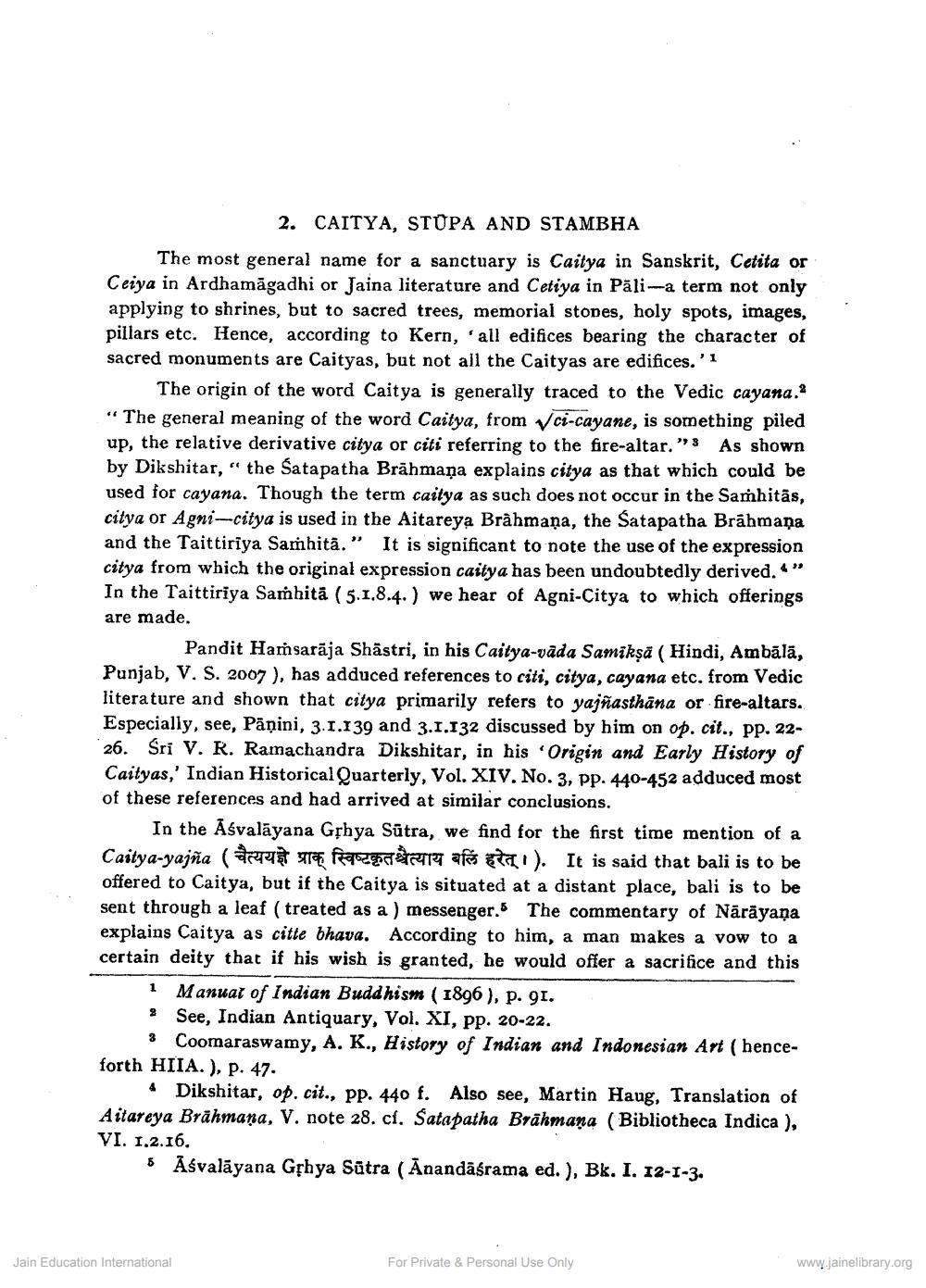________________
2. CAITYA, STUPA AND STAMBHA
The most general name for a sanctuary is Caitya in Sanskrit, Celita or Ceiya in Ardhamägadhi or Jaina literature and Cetiya in Päli-a term not only applying to shrines, but to sacred trees, memorial stones, holy spots, images, pillars etc. Hence, according to Kern, all edifices bearing the character of sacred monuments are Caityas, but not all the Caityas are edifices.'1
The origin of the word Caitya is generally "The general meaning of the word Caitya, from up, the relative derivative citya or citi referring to the fire-altar. " by Dikshitar," the Satapatha Brahmana explains citya as that which could be used for cayana. Though the term caitya as such does not occur in the Samhitas, citya or Agni-citya is used in the Aitareya Brahmana, the Satapatha Brahmana. and the Taittiriya Samhitä." It is significant to note the use of the expression citya from which the original expression caitya has been undoubtedly derived." In the Taittiriya Samhita (5.1.8.4.) we hear of Agni-Citya to which offerings are made.
traced to the Vedic cayana." ci-cayane, is something piled
Pandit Harhsarāja Shastri, in his Caitya-vada Samikṣā (Hindi, Ambala, Punjab, V. S. 2007), has adduced references to cili, citya, cayana etc. from Vedic literature and shown that citya primarily refers to yajñasthäna or fire-altars. Especially, see, Panini, 3.1.139 and 3.1.132 discussed by him on op. cit., pp. 2226. Sri V. R. Ramachandra Dikshitar, in his 'Origin and Early History of Caityas,' Indian Historical Quarterly, Vol. XIV. No. 3, pp. 440-452 adduced most of these references and had arrived at similar conclusions.
In the Asvalayana Grhya Sutra, we find for the first time mention of a Caitya- yajña (चेत्ययहे प्राक् स्विष्टकृत वैत्याय बलिं हरेत्). It is said that bali is to be offered to Caitya, but if the Caitya is situated at a distant place, bali is to be sent through a leaf (treated as a ) messenger. The commentary of Nārāyaṇa explains Caitya as cille bhava. According to him, a man makes a vow to a certain deity that if his wish is granted, he would offer a sacrifice and this
1 Manual of Indian Buddhism (1896), p. 91.
2 See, Indian Antiquary, Vol. XI, pp. 20-22.
3 Coomaraswamy, A. K., History of Indian and Indonesian Art (henceforth HIIA.). P. 47
Dikshitar, op. cit., pp. 440 f. Also see, Martin Haug, Translation of Aitareya Brahmana, V. note 28. cf. Satapatha Brahmana (Bibliotheca Indica ),
VI. 1.2.16.
Asvalayana Grbya Sätra (Anandâśrama ed.), Bk. I. 12-1-3.
Jain Education International
For Private & Personal Use Only
www.jainelibrary.org




